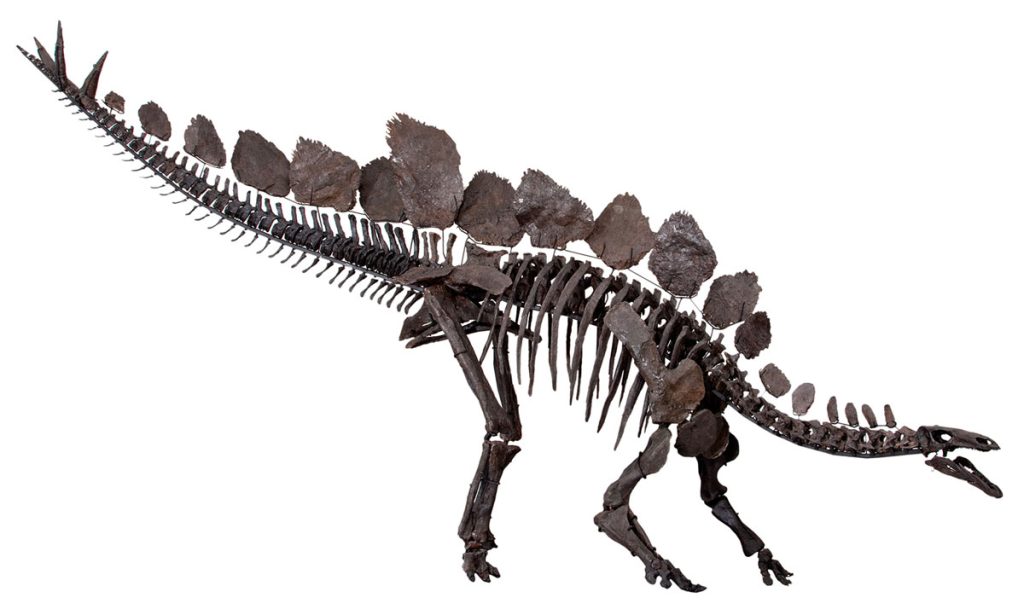Scientific Name
Stegosaurus stenops
Description
The Stegosaurus was an herbivorous (plant-eating) dinosaur that lived during the Late Jurassic period. It was a quadruped, meaning it walked on all four legs. The Stegosaurus was the best known of the stegosaur group. All told there were 11 different kinds of stegosaurs. The Stegosaurus was the only “plated” dinosaur that was found in western North America. Stegosaurs were very distinct-looking dinosaurs. They had many bony plates on their backs, which are also called “dermal plates” or “dermal armor”. The number of plates and their placement or appearance depended upon the individual stegosaur species, and was probably one way that each species could identify others of their own kind. The plates of the Stegosaurus ran in two rows down its back, in an alternating pattern. Paleontologists think that these plates were a way of regulating body temperature in some way, alternately absorbing heat from the sun when the Stegosaurus needed warmth or dissipating excess body heat when necessary. Some theories also state that these plates made the Stegosaurus look bigger to its enemies, which was a sort of defense against predators. Another distinct feature of the Stegosaurus was its spiked tail. It had 4 spikes or spines on the end of its tail. Other stegosaur species had up to 8 spikes on their tails, depending on the species they were. The front legs of the Stegosaurus were a bit shorter than the rear legs, and powerful shoulder and leg muscles supported its weight, estimated to be between 5 and 10 tons. Its gait when it walked was probably very similar to the elephant of today. Its front feet each had 5 short toes, and its hind feet each had 3 toes. It stood about 14 feet tall on all four legs.
Food
The Stegosaurus most likely preferred ferns, which grew in abundance during the Late Jurassic period in response to the heavy rains and climate of that time. It also might have eaten vegetation from conifers or other trees, as well as seeds from these plants. It was a low-level browser, meaning that it fed on vegetation that was easiest to reach. It ate plants and vegetation that was at a height of 3-4 feet or less. The tips of the jaws of the Stegosaurus were covered by horny sheaths called rhamphothecae, which the Stegosaurus used to bite off or strip off the leaves or vegetation before chewing or grinding it up. Its teeth were adapted to grind up its food before swallowing it. There are theories that say that the Stegosaurus digested its food either in a gizzard (like modern birds of today do) or in its stomach. It may have swallowed stones, or gastroliths, that would help to break down and digest the tougher vegetation.
Habitat
Skeletal evidence indicates that the Stegosaurus lived most of its life on the floodplains of ancient western North America. It may have preferred to live near water or wetter areas, where more of its food might have been easier to find.
Predators
Since the Stegosaurus was an herbivore, it often was the object of interest to hungry carnivorous predators such as the Tyrannosaurus Rex. The Stegosaurus would stand its ground and defend itself, using its spiny tail. The spines or spikes were 1.5 to 2 feet long, and the Stegosaurus would swing its tail like a club, trying to drive its enemies away.

Social Structure
Unfortunately it is hard to judge very much about the behavior of the Stegosaurus because all the evidence of its existence that is left is its fossils. But paleontologists believe that the brain of the Stegosaurus was small – about the size of a walnut or a golf ball – compared to the size of its huge body. This might mean that the Stegosaurus relied on its dermal plates or armor and its tail spikes as its defense, rather than running away from its enemies as some other herbivores did. Some theories state that the Stegosaurus lived in herds, which may have offered it more protection from predators.
Birth & Offspring
As with other dinosaurs, the Stegosaurus laid eggs. The number of eggs in a clutch is uncertain, but is guessed to be six or more per clutch. Once hatched, the young probably had to be fairly self-sufficient in a short time, in order for them to survive. But there are also some paleontologists that say that dinosaurs took care of their young much as modern birds do now, watching over their nests and even bringing the newly hatched little dinos their food. The plates on the Stegosaurus’ back may have also played a part in courtship rituals or displays, and the spiked tail may have been used when fighting with rivals during mating season.
Senses
The eyes of the Stegosaurus were located on either side of its head. This made it easier to spot potential danger, such as an approaching predator, more quickly. Smell may have played a big part in predator detection, as well, but also was important in helping to find the plants that the Stegosaurus liked to eat best.

Lydia King is a huge animal lover and has always been fascinated with learning about the animal kingdom. She enjoys writing about anything animal related from scientific information about rare species to animal references in pop culture.












